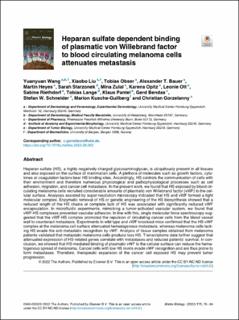| dc.contributor.author | Wang, Yuanyuan | |
| dc.contributor.author | Liu, Xiaobo | |
| dc.contributor.author | Obser, Tobias | |
| dc.contributor.author | Bauer, Alexander T. | |
| dc.contributor.author | Heyes, Martin | |
| dc.contributor.author | Starzonek, Sarah | |
| dc.contributor.author | Zulal, Mina | |
| dc.contributor.author | Opitz, Karena | |
| dc.contributor.author | Ott, Leonie | |
| dc.contributor.author | Riethdorf, Sabine | |
| dc.contributor.author | Lange, Tobias | |
| dc.contributor.author | Pantel, Klaus | |
| dc.contributor.author | Bendas, Gerd | |
| dc.contributor.author | Schneider, Stefan W. | |
| dc.contributor.author | Gullberg, Marion Kusche | |
| dc.contributor.author | Gorzelanny, Christian | |
| dc.date.accessioned | 2023-03-13T12:09:21Z | |
| dc.date.available | 2023-03-13T12:09:21Z | |
| dc.date.created | 2022-09-20T13:49:04Z | |
| dc.date.issued | 2022 | |
| dc.identifier.issn | 0945-053X | |
| dc.identifier.uri | https://hdl.handle.net/11250/3057939 | |
| dc.description.abstract | Heparan sulfate (HS), a highly negatively charged glycosaminoglycan, is ubiquitously present in all tissues and also exposed on the surface of mammalian cells. A plethora of molecules such as growth factors, cytokines or coagulation factors bear HS binding sites. Accordingly, HS controls the communication of cells with their environment and therefore numerous physiological and pathophysiological processes such as cell adhesion, migration, and cancer cell metastasis. In the present work, we found that HS exposed by blood circulating melanoma cells recruited considerable amounts of plasmatic von Willebrand factor (vWF) to the cellular surface. Analyses assisted by super-resolution microscopy indicated that HS and vWF formed a tight molecular complex. Enzymatic removal of HS or genetic engineering of the HS biosynthesis showed that a reduced length of the HS chains or complete lack of HS was associated with significantly reduced vWF encapsulation. In microfluidic experiments, mimicking a tumor-activated vascular system, we found that vWF-HS complexes prevented vascular adhesion. In line with this, single molecular force spectroscopy suggested that the vWF-HS complex promoted the repulsion of circulating cancer cells from the blood vessel wall to counteract metastasis. Experiments in wild type and vWF knockout mice confirmed that the HS-vWF complex at the melanoma cell surface attenuated hematogenous metastasis, whereas melanoma cells lacking HS evade the anti-metastatic recognition by vWF. Analysis of tissue samples obtained from melanoma patients validated that metastatic melanoma cells produce less HS. Transcriptome data further suggest that attenuated expression of HS-related genes correlate with metastases and reduced patients’ survival. In conclusion, we showed that HS-mediated binding of plasmatic vWF to the cellular surface can reduce the hematogenous spread of melanoma. Cancer cells with low HS levels evade vWF recognition and are thus prone to form metastases. Therefore, therapeutic expansion of the cancer cell exposed HS may prevent tumor progression. | en_US |
| dc.language.iso | eng | en_US |
| dc.publisher | Elsevier | en_US |
| dc.rights | Attribution-NonCommercial-NoDerivatives 4.0 Internasjonal | * |
| dc.rights.uri | http://creativecommons.org/licenses/by-nc-nd/4.0/deed.no | * |
| dc.title | Heparan sulfate dependent binding of plasmatic von Willebrand factor to blood circulating melanoma cells attenuates metastasis | en_US |
| dc.type | Journal article | en_US |
| dc.type | Peer reviewed | en_US |
| dc.description.version | publishedVersion | en_US |
| dc.rights.holder | Copyright 2022 The Author(s) | en_US |
| cristin.ispublished | true | |
| cristin.fulltext | original | |
| cristin.qualitycode | 1 | |
| dc.identifier.doi | 10.1016/j.matbio.2022.06.002 | |
| dc.identifier.cristin | 2053568 | |
| dc.source.journal | Matrix Biology | en_US |
| dc.source.pagenumber | 76-94 | en_US |
| dc.identifier.citation | Matrix Biology. 2022, 111, 76-94. | en_US |
| dc.source.volume | 111 | en_US |

